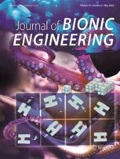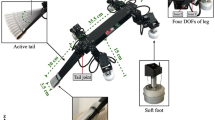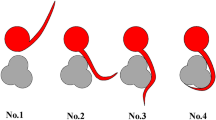Abstract
Many animals exhibit strong mechanical interlocking in order to achieve efficient climbing against rough surfaces by using their claws in the pads. To maximally use the mechanical interlocking, an innovative robot which utilizes flexible pad with claws is designed. The mechanism for attachments of the claws against rough surfaces is further revealed according to the theoretical analysis. Moreover, the effects of the key parameters on the performances of the climbing robots are obtained. It indicates that decreasing the size of the tip of the claws while maintaining its stiffness unchanged can effectively improve the attachment ability. Furthermore, the structure of robot body and two foot trajectories are proposed and the new robot is presented. Using experimental tests, it demonstrates that this robot has high stability and adaptability while climbing on vertical rough surfaces up to a speed of 4.6 cm·s−1.
Similar content being viewed by others
References
Aravind S R, Mary A, Raju S N, Ravi A G, Sharma V, Bala G. A novel design technique to develop a low cost and highly stable wall climbing robot. International Conference on Intelligent Systems, Modelling and Simulation, 2013, 360–363.
Rosa G L, Messina M, Muscato G, Sinatra R. A low-cost lightweight climbing robot for the inspection of vertical surfaces. Mechatronics, 2002, 12, 71–96.
Zhu J, Sun D, Tso S K. Development of a tracked climbing robot. Journal of Intelligent & Robotic Systems, 2002, 35, 427–443.
Kim H, Kim D, Yang H, Lee K, Seo K, Chang D, Kim J. Development of a wall-climbing robot using a tracked wheel mechanism. Journal of Mechanical Science and Technology, 2008, 22, 1490–1498.
Balaguer C, Gimenez A, Pastor J M, Padron V M, Abderrahim M. A climbing autonomous robot for inspection applications in 3d complex environments. Robotica, 2000, 18, 287–297.
Ma P, Chen J, Yu X. A wall-climbing robot for labeling scale of oil tank’s volume. Robotica, 2002, 20, 209–212.
Hirose S, Tsutsumitake H. Disk rover: A wall-climbing robot using permanent. Proceedings of the IEEE/RSJ International Conference on Intelligent Robots and Systems, Raleigh, USA, 1992, 2074–2079.
Shen W, Gu J, Shen Y. Proposed wall climbing robot with permanent magnetic tracks for inspecting oil tanks. Proceedings of IEEE International Conference on Mechatronics and Automation, Niagara Falls, Canada, 2005, 2072–2077.
Kim S, Spenko M, Trujillo S, Heyneman B, Mattoli V, Cutkosky M R. Whole body adhesion: Hierarchical, directional and distributed control of adhesive forces for a climbing robot. IEEE International Conference on Robotics & Automation, Roma, Italy, 2007, 1268–1273.
Henrey M, Ahmed A, Boscariol P, Shannon L, Menon C. Abigaille-III: A versatile, bioinspired hexapod for scaling smooth vertical surfaces. Journal of Bionic Engineering, 2014, 11, 1–17.
Peyvandi A, Soroushian P, Lu J. A new self-loading locomotion mechanism for wall climbing robots employing biomimetic adhesives. Journal of Bionic Engineering, 2013, 10, 12–18.
Dan S, Li Y, Menon C. Multi-scale compliant foot designs and fabrication for use with a spider-inspired climbing robot. Journal of Bionic Engineering, 2008, 5, 189–196.
Ji A, Han L, Dai Z. Adhesive contact in animal: Morphology, mechanism and bio-inspired application. Journal of Bionic Engineering, 2011, 8, 345–356.
Dai Z D, Gorb S. Contact mechanics of pad of grasshopper (Insecta: ORTHOPTERA) by finite element methods. Chinese Science Bulletin, 2009, 54, 549–555.
Federle W, Barnes W J, Baumgartner W, Drechsler P, Smith J M. Wet but not slippery: Boundary friction in tree frog adhesive toe pads. Journal of the Royal Society Interface, 2006, 3, 689–697.
Jiao Y, Gorb S, Scherge M Jiao Y K. Adhesion measured on the attachment pads of Tettigonia viridissima (Orthoptera, insecta). Journal of Experimental Biology, 2000, 203, 1887–1895.
Autumn K, Sitti M, Liang Y A, Peattie A M, Hansen W R, Sponberg S, Kenny T W, Fearing R, Israelachvili J N, Full R J. Evidence for van der Waals adhesion in gecko setae. Proceedings of the National Academy of Sciences of the United States of America, 2002, 99, 12252–12256.
Autumn K, Liang Y A, Hsieh S T, Zesch W, Chan W P, Kenny T W, Fearing R, Full R J. Adhesive force of a single gecko foot-hair. Nature, 2000, 405, 681–685.
Roth L M, Willis E R. Tarsal structure and climbing ability of cockroaches. Journal of Experimental Zoology, 1952, 119, 483–517.
Kim S, Asbeck A T, Cutkosky M R, Provancher W R. SpinybotII: Climbing hard walls with compliant microspines. Proceedings of 12th International Conference on Advanced Robotics, Seattle, USA, 2005, 601–606.
Asbeck A T, Kim S, McClung A, Parness A, Cutkosky M R. Climbing walls with microspines. Proceedings of the IEEE International Conference on Robotics and Automation, Orlando, USA, 2006, 449–458.
Autumn K, Buehler M, Cutkosky M, Fearing R, Full R J, Goldman D, Groff R, Provancher W, Rizzi A A, Saranli U, Saunders A, Koditschek D E. Robotics in scansorial environments. SPIE Proceedings, 2005, 5804, 291–302.
Saunders A, Goldman D I, Full R J, Buehler M. The RiSE climbing robot: Body and leg design. SPIE Proceedings, 2006, 6230, 623017.
Spenko M J, Haynes G C, Saunders J A, Cutkosky M R, Rizzi A A, Full R J, Koditschek D E. Biologically inspired climbing with a hexapedal robot. Journal of Field Robotics, 2008, 25, 223–242.
Haynes G C, Khripin A, Lynch G, Amory J, Saunders A, Rizzi A A, Koditschek D E. Rapid pole climbing with a quadrupedal robot. Proceedings of IEEE International Conference on Robotics and Automation, Kobe, Japan, 2009, 2767–2772.
Cutkosky M R, Kim S. Design and fabrication of multi-material structures for bioinspired robots. Philosophical Transactions of the Royal Society a Mathematical Physical & Engineering Sciences, 2009, 367, 1799–1813.
Liu Y, Sun S, Wu X, Mei T. A wheeled wall-climbing robot with bio-inspired spine mechanisms. Journal of Bionic Engineering, 2015, 12, 17–28.
Frantsevich L, Gorb S. Structure and mechanics of the tarsal chain in the hornet, Vespa crabro (Hymenoptera: Vespidae): Implications on the attachment mechanism. Arthropod Structure & Development, 2004, 33, 77–89.
Dai Z D, Gorb S U, Schwarz U. Roughness-dependent friction force of the tarsal claw system in the beetle Pachnoda marginata (Coleoptera, Scarabaeidae). Journal of Experimental Biology, 2002, 205, 2479–2488.
Asbeck A T, Kim S, Cutkosky M R, Provancher W R, Lanzetta M. Scaling hard vertical surfaces with compliant microspine arrays. International Journal of Robotics Research, 2006, 25, 1165–1179.
Wang Z, Dai Z, Ji A, Ren L, Xing Q, Dai L. Biomechanics of gecko locomotion: The patterns of reaction forces on inverted, vertical and horizontal substrates. Bioinspiration & Biomimetics, 2015, 10, 016019.
Acknowledgment
This work was supported by the National Natural Science Foundation of China (51375232) and Key Plan of Research and Development of Jiangsu Province (BE2017766).
Author information
Authors and Affiliations
Corresponding author
Rights and permissions
About this article
Cite this article
Ji, A., Zhao, Z., Manoonpong, P. et al. A Bio-inspired Climbing Robot with Flexible Pads and Claws. J Bionic Eng 15, 368–378 (2018). https://doi.org/10.1007/s42235-018-0028-6
Published:
Issue Date:
DOI: https://doi.org/10.1007/s42235-018-0028-6




